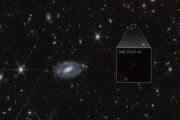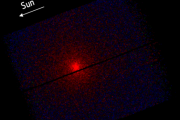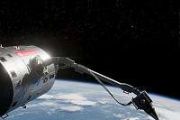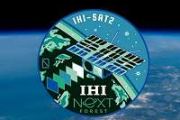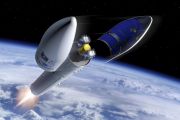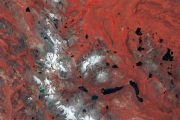
Copernical Team
Salts and organics observed on Ganymede's surface by June
 Data collected by NASA's Juno mission indicates a briny past may be bubbling to the surface on Jupiter's largest moon. NASA's Juno mission has observed mineral salts and organic compounds on the surface of Jupiter's moon Ganymede. Data for this discovery was collected by the Jovian InfraRed Auroral Mapper (JIRAM) spectrometer aboard the spacecraft during a close flyby of the icy moon. The findin
Data collected by NASA's Juno mission indicates a briny past may be bubbling to the surface on Jupiter's largest moon. NASA's Juno mission has observed mineral salts and organic compounds on the surface of Jupiter's moon Ganymede. Data for this discovery was collected by the Jovian InfraRed Auroral Mapper (JIRAM) spectrometer aboard the spacecraft during a close flyby of the icy moon. The findin SpaceX launches 23 Starlink Internet satellites after aborted mission
 SpaceX launched 23 Starlink Internet satellites into low-Earth orbit from Space Launch Complex 40 at Cape Canaveral Space Force Station in Florida on Monday in its second attempt after aborting the mission Sunday.
The successful second launch attempt was the eighth flight for the first stage booster supporting this mission, which previously launched Crew-5, GPS III Space Vehicle 06, Imm
SpaceX launched 23 Starlink Internet satellites into low-Earth orbit from Space Launch Complex 40 at Cape Canaveral Space Force Station in Florida on Monday in its second attempt after aborting the mission Sunday.
The successful second launch attempt was the eighth flight for the first stage booster supporting this mission, which previously launched Crew-5, GPS III Space Vehicle 06, Imm To advance space colonization, WVU research explores 3D printing in microgravity
 Research from West Virginia University students and faculty into how 3D printing works in a weightless environment aims to support long-term exploration and habitation on spaceships, the moon or Mars.
Extended missions in outer space require the manufacture of crucial materials and equipment onsite, rather than transporting those items from Earth. Members of the Microgravity Research Team
Research from West Virginia University students and faculty into how 3D printing works in a weightless environment aims to support long-term exploration and habitation on spaceships, the moon or Mars.
Extended missions in outer space require the manufacture of crucial materials and equipment onsite, rather than transporting those items from Earth. Members of the Microgravity Research Team Demonstration of data transmission from a microsatellite by laser
 Small satellites are becoming increasingly compact and powerful. The technology of conventional radio channels is reaching its limits due to the rising number of satellites. Laser communications offers solutions for the efficient transmission of high data volumes without interfering with other channels. For this application, the German Aerospace Center Institute of Communications and Navigation,
Small satellites are becoming increasingly compact and powerful. The technology of conventional radio channels is reaching its limits due to the rising number of satellites. Laser communications offers solutions for the efficient transmission of high data volumes without interfering with other channels. For this application, the German Aerospace Center Institute of Communications and Navigation, Private sector actively competing for involvement in China's space station, manned lunar missions
 China's private space enterprises are hopeful that commercial rockets developed by them will be involved in the launch missions of the low-cost cargo transport vehicle for the country's space station, announced a senior official with the China Manned Space Agency (CMSA) at a press conference on Wednesday.
In proposals provided by space enterprises for China's space station low-cost cargo t
China's private space enterprises are hopeful that commercial rockets developed by them will be involved in the launch missions of the low-cost cargo transport vehicle for the country's space station, announced a senior official with the China Manned Space Agency (CMSA) at a press conference on Wednesday.
In proposals provided by space enterprises for China's space station low-cost cargo t USound and Physical Synthesis to send the tiniest speaker to space
 USound, the leading provider of advanced audio solutions from Austria, announced that it has been selected by Physical Synthesis, a US-based hardware startup that builds state-of-the-art musical instruments, for the completion of a challenging space project named "Blue Marble: Put a Musical Synthesizer in Space!". The project entails the design of a zero-gravity synthesizer that will be launched
USound, the leading provider of advanced audio solutions from Austria, announced that it has been selected by Physical Synthesis, a US-based hardware startup that builds state-of-the-art musical instruments, for the completion of a challenging space project named "Blue Marble: Put a Musical Synthesizer in Space!". The project entails the design of a zero-gravity synthesizer that will be launched Groundbreaking method for robotic space assembly inspired by human arm dynamics
 In the ever-evolving landscape of space technology, the role of robots in the assembly and maintenance of spacecraft is growing significantly. As reliance on robotic manipulators increases, the traditional methods of control are proving to be less efficient, particularly in complex assembly processes. In a recently published paper in Cyborg and Bionic Systems, researchers at Beijing Institute of
In the ever-evolving landscape of space technology, the role of robots in the assembly and maintenance of spacecraft is growing significantly. As reliance on robotic manipulators increases, the traditional methods of control are proving to be less efficient, particularly in complex assembly processes. In a recently published paper in Cyborg and Bionic Systems, researchers at Beijing Institute of 3 astronauts return to Earth after 6-month stay on China's space station

Spooky sights from space: world’s largest acidic lake
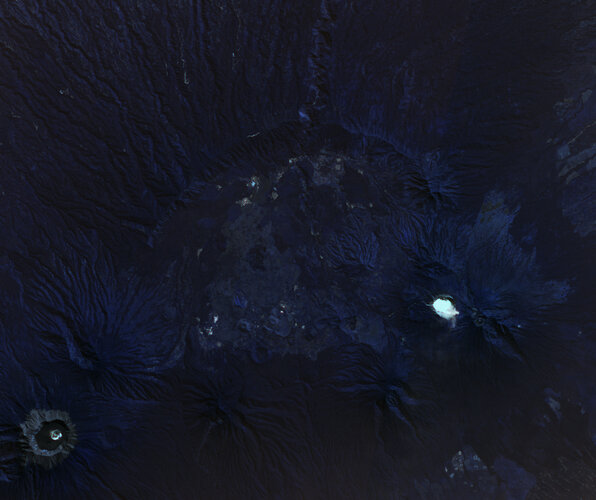 Image:
What’s spookier than the ‘largest acid cauldron on Earth?’ In East Java, Indonesia, lies the Kawah Ijen Crater Lake – the world’s largest acidic lake, a chilling spectacle perfect for Halloween.
Image:
What’s spookier than the ‘largest acid cauldron on Earth?’ In East Java, Indonesia, lies the Kawah Ijen Crater Lake – the world’s largest acidic lake, a chilling spectacle perfect for Halloween. Australian school students are experimenting with 'space veggies' in a NASA initiative

A pink glow is shining on the faces of enthusiastic students as they tend to plants in purpose-built grow boxes for space stations.
These students are the first in Australia to experience Growing Beyond Earth—a schools citizen science program from NASA and Fairchild Tropical Botanic Garden in the United States.
In Australia, Royal Botanic Gardens Victoria is working with the La Trobe Institute for Agriculture and Food, and Melbourne Archdiocese of Catholic Schools. The educational initiative ties into the Australian curriculum and gives students a unique introduction to gardening through science.
In this project, students grow plants in controlled conditions to test if they would be suitable for NASA missions, to help feed a future cadre of astronauts.
Plants evolved on Earth, so they might not grow so well in space.






